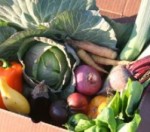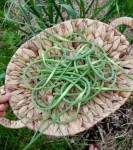This post may contain affiliate links. Read our disclosure here.

We have recently talked about the benefits of the Farmer’s Market as well as the differences of organic vs. local produce. In all this produce talk, we have yet to mention a produce program that everyone should know about. Let me tell you about CSA or Community Supported Agriculture that supports local farmers and and provides you with some neat produce!
 CSA 101
CSA 101
What is a CSA? CSA stands for Community Supported Agriculture. CSA’s are started by the farmer in an effort to sell their goods. When you typically buy a CSA, you’re paying the farmer directly for a “share” of their crops- the freshest produce in town!
CSA’s are sold by the unit (weekly), by the season (spring, summer), or by the year. You sign up and pay for your CSA in advance, then go to the weekly pick up point (either the farm or a local spot in the community) to collect a box of freshly-picked, local produce.
Benefits to You
-Freshness. Each week you will receive a box of the freshest produce imaginable. You can’t get anything more fresh unless you pick it yourself! Fresher produce = more nutrients.
-Surprise! Since you have zero control over what appears in your weekly box, you’re likely to receive fruits or veggies you wouldn’t normally buy. You will get to try several new foods and you may even discover some new favorites.
-Meet the farmer. Most farms will invite their CSA shareholders to visit the farm. You’ll get to see how and where your food is grown. If you get this chance, bring the kids! By seeing where their food is grown, they are more likely to get seriously enthusiastic about their veggies.
-Support. Need ideas on how to use your produce? Farmers KNOW their food. Ask for recipe ideas.
What’s in it for the farmer?
Your local farmer creates a CSA to help sell their harvest. CSA sales begin way before the harvest is even close to ready, giving the farmer a chance to do all their time-consuming marketing during the growing season and not the busy harvest season. These CSA sales bring in cash flow early in the season. Farmers get a good, fair price for their goods, and they get to deliver them directly to the customer.
Dealing with the Weird
So, if you’ve ever been part of a CSA before, you will always remember the first time you open your box and find that thing…that mystery vegetable. You have no idea what it is, let alone how to eat it. For me, it was kohlrabi (pictured). It looks like collard leaves on the top and an oddly engorged broccoli stalk on the bottom. It also comes in a violent purple color which can really confuse you.

You have three choices:
1. Give it away.
2. Place it in your refrigerator until you figure out how to use it but deep down you know it’s going to go bad before you figure it out.
3. Google it and learn some great ways to cook it.
Personally, I love the weird. :) I think it’s fun to work with a new food and try new recipes or work new veggies into our standard recipes. A lot of the “weird” produce can be substituted for your normal veggies. When you get a new, strange vegetable, look it up and see what else is in its family and try cooking it in a similar way:
Root Vegetables – potatoes, carrots, beets, turnips, radishes
Tough Greens – kale, chard, collards
Soft Greens – lettuce, herbs, watercress
Gourds – various squash
Stalk Vegetables – celery, asparagus, kohlrabi, chard
Overwhelmed with chard? Chop it up and saute it like collard greens or add them into your morning omelet or frittata.
Weirded out by an enormous daikon radish? Slice it up and roast it with sesame oil into daikon fries (which are delicious and low-carb too!).
Completely unenthusiastic about using a leek? Its mellow onion flavor will complement any soup.
When I have something weird to use, it will most likely end up in a soup, frittata, or roasted. Easy and low-maintenance. If all else fails, I’ll just juice it. Do you have any tricks for using odd veggies? Any favorite “weird” vegetables you like to buy? I’ve discovered a new favorite, garlic scapes (below), thanks to my CSA box. Garlic flavor without the spicy bite.

How Much Does a CSA Cost?
You can expect to pay $300-600 for a seasonal share (about 10-15 weeks), buying you a big ol’ box of fresh produce every week. You will usually pay upfront for the entire season. Here are some prices I found locally:
$30/week, 10 week minimum: 6-10 lbs of whatever is in season for the week with the addition of a treat which may be bread, jelly, jam, or homemade candy.
$25/week, 15 week minimum
$300/15 weeks for 4-5 lbs of produce, $525/15 weeks for 8-10 lbs, egg add-on optional
$25/week + $45 seasonal (3-month) membership fee: 6-10 different varieties of produce
$600/24 weeks ($25/week): 6-8 varieties of fresh vegetables
You’ll spend about $25-35 per week on your CSA box and get a lot of produce. For my family of five, it is usually enough to get us through the week with some additions from the store. However, I’m a wee bit lazy and don’t do a traditional CSA. I get my box delivered straight to my door using…
3rd Party CSA Services
A regular CSA is run out of one farm. A 3rd Party CSA Service works with multiple local farms.
The CSA service will coordinate with local farms to pick up their offerings every week. You benefit from a wider variety of produce. You may or may not have a 3rd party CSA service in your area, but if you do, check them out. Here, in the Atlanta area, we have Nature’s Garden Express. [It’s the only one I’ve tried, so my experience is based on this one company.]
Benefits: My CSA service is a well-oiled machine. I can sign up online, specify my preferences (as in never, ever put mustard greens in my order) and add on extras like eggs, cheese, local milk, grass-fed beef. I can even go online, see what’s scheduled for my box and make up to 3 substitutions. I can put my account on vacation hold if I go out of town for a week. They deliver right to my front door every Thursday (for free!) and leave ice packs if I’m not home. I don’t have to pay a sign-up fee and there’s no commitment. It really is very easy and customer-friendly.
Drawbacks: You will pay more for an accommodating CSA service. I subscribe to the “small” box of 100% local and organic produce for $38 per week. I can add-on pasture-raised eggs for $5/dozen. I know I’m paying a higher price for convenience, but I like the flexibility. I like having a choice about what’s in my box. I know that I will use all of this, and it will not be wasted. Plus, it’s not easy to find local + organic, so I am willing to pay someone else to do the legwork for me.
Tips to make a customized service more affordable:
If you purchase a larger sized box you get more bang for your buck! Team up with a friend (or two) to share a large box every week. You’ll get additional varieties + larger quantities, almost 3x the food for less than 2x the price!
Choose co-op delivery instead of home delivery for a discount.
Don’t have a co-op nearby? Know of at least 3 other people that would buy a weekly box? Host your own co-op! You get a lower price for being part of a co-op delivery.
Tips for Choosing a CSA
-Don’t expect a CSA to supply 100% of the produce you need. You may still have to supplement some items from the store.
-Before you sign up, ASK ABOUT THEIR POLICIES. What happens if you can’t pick up your box one week? Can you make substitutions? What are their growing practices? Know what you’re buying.
-Find all the CSA’s in your area and see which one is right for you. Use Local Harvest’s CSA search feature to locate local farms. You can learn about what they grow and give them a call to get more details about their CSA.
-If you would like to support your local farm but can’t commit to a weekly box, call them to see how/when you can buy outside the CSA.
-Ask a farm about buying extra produce in bulk. You can buy a large quantity of in-season produce to freeze, dehydrate, or can for the winter.
Have you ever been part of a CSA? Do you think you’ll try one in the future? What experiences have you had?
Next week…
Love the idea of freshly-picked, organically-grown produce? Want it for (almost) free? Let’s grow it! Next week, we’re going to talk about how to grow your own organic vegetable garden. My husband has been trying to get our garden to grow ANYTHING for the past two years. This year, we are determined to produce something! Any tips to share as we begin our organic gardening journey?
The following is part of an Organic Living Journey Guest Post Series now written by Mariana who has a mother’s heart and scientist’s brain.


